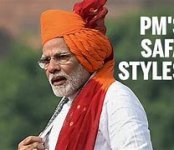GR66
Army.ca Veteran
- Reaction score
- 4,304
- Points
- 1,160
Reference?As for Jagmeet Singh, it is not his gold watch and expensive suits that the Indians comment on. It is that big saffron turban. That is like a red rag to a bull or the IRA wearing green. It is a sign of allegiance to the Khalistani cause.
From the World Sikh Organization website:
And from another site:WHAT IS THE SIGNIFICANCE OF THE TURBAN’S COLOUR AND STYLE?
None necessarily. Although traditionally Sikh turbans are white, black, blue and yellow/ orange, many Sikhs wear other colours and shades to suit their personal preferences. It is a personal choice. There are several styles of Sikh turbans and these too are chosen as a personal preference.
When we often look at the Sikh turban, we automatically associate it with identification of religion; that is how you identify a Sikh. Have you ever questioned why an individual is wearing a specific turban colour? Whether there is a deeper association?
The colour of a turban can go far beyond being a simple fashion-outfit coordination, it can provide a deeper significance and meaning towards mentality, spirituality, and living.
Orange and Blue Turbans
Orange and Blue turbans are known as the Sikh Khalsa colours.
The blue represents ‘warrior’ - someone who will protect their faith and protect the good. It also serves as a reminder of the bravery of previous generations and their fight against oppression. Both orange and blue are a representation and reminder of Sikh history and wars in which the colours were worn.
There are many shades within the blue colour spectrum. Here are some of the most popular ones associated with turban colours (from light to dark):
The colour orange on the other hand represents wisdom. Wisdom has been embedded in Sikhi since the first Guru Nanak Dev Ji, who taught all of us that ‘we are all one, we are one with God and God is a part of us’. The colour orange also represents courage and knowledge which are two qualities practiced within Sikhism.
- Baby Blue
This colour is a delicate and pale shade of blue that is often associated with a sense of calmness, tranquillity, and innocence. It gained popularity during the Renaissance period in Europe when artists started using new pigments derived from minerals and gemstones. In the early 20th century, baby blue began to be associated with newborn babies, hence the name. It became a traditional colour for baby boys' clothing and nursery decorations, as blue was considered a more masculine colour compared to pink.- German Blue
This shade of blue is named German Blue simply because this is where the chemical process dye for the colour originated from. Blue is a colour that has long been associated with royalty, art, military, business and nature. This particular shade is bright and portrays power and valiance. This is the ideal spring/summer colour, and can be worn both casually and smartly.- Royal Blue
Royal blue is a deep, vivid blue. It is lighter than navy blue, but darker with a slightly more purple hue than German Blue. The colour royal blue has regal associations, thanks to its historical connection to the British throne. This makes it a popular choice for suits, bridesmaid dresses and formal outfits. This colour is associated with trustworthiness and reliability. It's a versatile colour that can be paired well with darker blues, orange, white or greys.- Navy Blue
Navy blue was first used after British Royal Navy officers wore uniforms in the colour in 1748. The uniforms proved so popular that the colour was eventually adopted by navies around the world. Our Navy Blue Turbans are so versatile, they can be easily paired up with greens, reds, greys and even purples. Navy Blue is a very popular turban shade - if you don't have this one in your closet, then it's definitely one you need to be adding.
Orange can also symbolise sacrifice and strength, which is why the colour is often paired with blue.
Blue and orange will therefore especially be recognised and worn at religious commemorations and observances as the colours represent a community; creating a sense of togetherness and being one.








